Airfix 1/72 Supermarine Swift FR 5
In the years immediately following the Second World War, the pace of aircraft development slowed in Britain. In part, this was due to the fact that no immediate enemy was perceived, which is a natural reason for governments to slow the pace of expenditures. On another level, though, Britain was literally worn out from the effort to win the Second World War; everyone seemed to slow their pace. Unfortunately, this would result in the British first generation jets the Meteor and the Vampire having to soldier on past their time. The decision not to pursue supersonic flight following the death of Geoffrey deHavilland in the D.H.108 meant there was no likelihood of "jumping a generation" of development. By the time the British swept wing fighters achieved initial service, the F 86 had been in service five years and had successfully fought a war.
Supermarine, the makers of the Spitfire the leading British fighter of the war seemed also to lose their step in the immediate post war years. The Spiteful was not a success, and their first jet fighter design, the Attacker, was thoroughly pedestrian in performance and backward in design with its conventional tailwheel landing gear. Hawker's competing Sea Hawk was by far the superior design.
With Hawker working on the initial design of the swept wing Hunter, Supermarine determined to enter the swept wing race with the Type 510, which was basically an Attacker with swept wings. Given the developmental background, it is not surprising that the 510s first flight on December 29, 1948, was the first flight of a British jet aircraft with swept wings and tailplane. Since it was powered by the centrifugal Rolls Royce Nene engine the fuselage of the Type 510 was larger than the Hunter. When VV106 went through carrier trials, it became the first swept wing jet anywhere to land and take off from a carrier. The 510 needed further development to improve performance at high speeds and altitudes, and the flight program demonstrated that greater stability was badly needed.
The 510 was modified to the Type 528, which shortly after its first flight on March 27, 1950, was modified to a nosewheel arrangement with a longer, pointed nose, a kinked wing leading edge, and larger fuselage diameter to accommodate an afterburner; now known as the Type 535, it first flew on August 23, 1950. As an aside, both the Type 510 and the Type 535 can be seen in the very good (even if very inaccurate) movie, "Breaking the Sound Barrier."
At this point, Hawker had flown the prototype Hunter, and was entering the prolonged testing period to find the proper location of the ventral dive brake and the correct shape for the shell collectors. With the Hunter's progress delayed, Supermarine was awarded a contract to produce 100 aircraft based on the Type 535, to be named Swift. Known to the company as the Type 541, power was changed from the Nene to the more powerful Rolls Royce Avon, which was also used in the Hunter. WJ960, the Swift prototype, first flew on August 1, 1951. The second, WJ965, did not fly until July, 1952, after which two forced landings caused a delay in the program.
The Swift F.1 first flew in March 1953. An armament increase from two 20mm cannon to four 30mm cannon resulted in the Swift F.2. Unfortunately, the extra room for the extra ammunition was created by extending the wings forward at the fuselage joint; flight test showed this caused a problem whereby the Swift could go into an abrupt pitch up attitude which resulted in the airplane going inverted in a matter of seconds. Extra ballast was added to the nose to correct this, which lowered performance. The ultimate cure was a variable-incidence horizontal stabilizer, which appeared in the F.4 that first flew in May 1953.
The F.4 was the Swift variant used to break the world absolute speed record on September 26, 1953; at 735 mph, the Swift, beat Neville Duke's record of 727 mph in a Hunter F.3 set three weeks earlier. Days later, the Douglas XF4D-1 Skyray established a record of 753 miles per hour, which would be broken within the year by the North American YF-100 Super Sabre.
The Swift F.1 reached 56 Squadron of Fighter Command on February 13, 1954, to become the first domestically-produced swept wing fighter to enter RAF service. By August 1954, a number of accidents resulted in the grounding of all Swifts. The restrictions were relaxed on August 30 with the arrival of the Swift F.2; however two aircraft were lost in pitch up accidents shortly thereafter and the Swifts were again grounded. In March 1955, Fighter Command ordered the withdrawal of the Swift from service when it was found that the F.4's afterburner could not be lit at high altitude, which ended its usefulness as an interceptor.
At this point, production then switched to the Type 549 F.R.5, a low level reconnaissance variant. The F.R.5, fitted with a lengthened nose housing cameras and armed with two 30mm cannon, was a useful aircraft; since it operated at medium to low level, the high altitude reheat problem did not matter. The F.R.5 joined 2 Squadron in Germany in March 1956. Pilots who flew the airplane discovered that at altitudes under 2,000 feet the optimum operating environment for a tactical recon fighter the airplane outperformed any other jet. In 1957 and 1959, 2 Squadron's Swifts won the NATO "Royal Flush" reconnaissance competition, beating the American RF-84F Thunderflash. The punishing low level tactical recon role proved no problem for the strong airframe; no fatigue problems were ever encountered. The F.R.5s were eventually replaced in 1961 by the Hunter F.R.10.
Often regarded as a complete failure, the Swift was from the start hampered by the problem associated in changing the engine from the Nene to the Avon and the lack of time to develop the aircraft. The airplane had only ever been intended as a back up in case the Hunter failed.
There have been at least two other injection-molded 1/72 Swift kits. The first was from Hawk, appearing some 63 years ago; it was actually a model of the Type 535 prototype. In terms of model quality it is largely an exercise in collectors nostalgia. Several years ago, Xtrakit brought out a Swift FR 5 in limited-run plastic (MPM) with nice decals. This kit from Airfix is the first “mainstream” injection-molded kit of this airplane, and is definitely the best.
The kit has detail that one might more expect in 1/48 than 1/72, with a nicely-detailed cockpit that includes an ejection seat with molded-in seatbelt detail, with decal instrument panels. The wheel wells are nicely detailed, as is the landing gear, and the flaps can be assembled raised or lowered, with good interior detail. The canopy is in two parts and is thin enough to look accurate in the open position. Surface detail is very petite engraved lines - the Airfix trench-digger has been retired (he's been missing from the Kate, the Whitley and the upcoming Stuka in 1/72 kits).
Decals are provided for No. II(AC) and 79 Squadrons, the two units that operated the FR 5. These are excellent, being thin and in register. The very complete stenciling can actually be read under a magnifying glass and is accurate.
I started by painting as much detail as I could with the parts on the trees. This was quite easy for the cockpit, since it is black; I used Tamiya NATO black for that. I picked out the seatbelt detail with a 00000 brush. I then assembled the cockpit and nose wheel well and inserted them in the fuselage. I filled the nose above the wheel well and ahead of the cockpit with pinched-shut “cannonball” fishweights. I then assembled the wing and attached the slipper tank, then attached the wing to the fuselage. Fit throughout was very precise; I only used Mr. Surfacer on the fuselage centerline. I attached the horizontal stabilizers and was ready for paint.
I painted the lower surface PRU Blue using a mixture of Tamiya paints. The upper surfaces were painted Tamiya Dark Grey and RAF Dark Green, following the camouflage pattern provided in the instructions. The windscreen and the canopy were hand painted with the 00000 brush. I then gave the model a coat of Future.
I used the decal options for the 79 Squadron Swift. They went down under a coat of Micro-Sol with no problem. I then gave the model a coat of Xtracrylix Satin varnish.
I attached the landing gear and flaps and positioned the canopy in the open position. I painted the exhaust with Tamiya Titanium Silver.
Definitely the best kit of this airplane in any scale. It would be nice if Airfix would consider scaling this one up to 1/48, as they have with their new Spitfire, Hurricane and Defiant first released in 1/72. Airfix continues to go from success to success with the new kits they are releasing. Highly recommended for anyone who likes 50s jets.
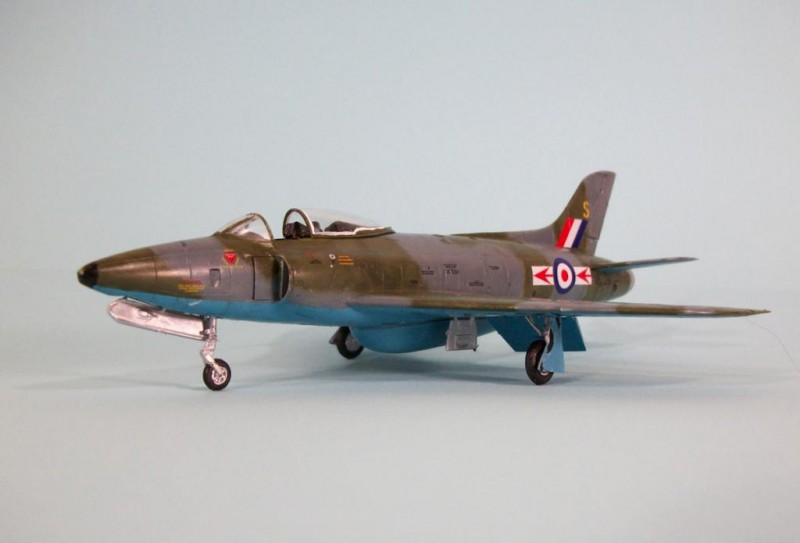

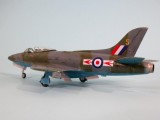


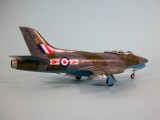

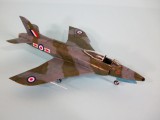
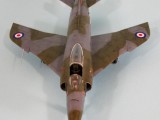
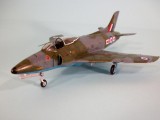
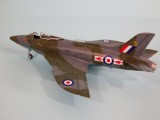
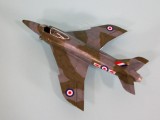
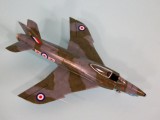
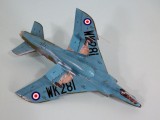
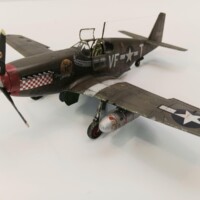


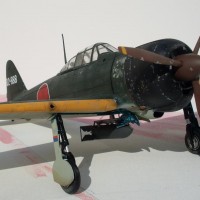
nice build im like
Very nice. I agree with Airfix reference for future production. Perhaps the wheels are in motion even as we speak...
I'm with Rob, I'd buy at least one if they do a 48th.
Still waiting for the Scimitar in either scale, (1/72 or 1/48) and a new 72nd correct Sea Vixen and Buccaneer.
Great build as always I see new Airfix is getting better and better.
I see new Airfix is getting better and better.
Nice work on what I consider to be a CLASSIC, it is not every day one sees a SWIFT. Thanks for the photos.
Great Swift Tom, and you've convinced me to give away the Hawk kit I have in my stash and spring for an Airfix kit!
Nice looking Swift, Tom. Something about that wing planform makes it very distinctive.
The Swift in 48 scale would be a sure winner. I still say that we need a Scimitar in 48 from Airfix as well. Great looking Swift Tom. I like it very much!
Given the times what with the "Cold War" going on ...it would seem that the Swift was a design that was always in development and held enough promise but, never matured until a niche was found for it in photo recon. Kind of like the F-101 Voodoo. Interesting bio and model as usual Tom. Its my understanding that Airfix had some issues with the molds and that the 1st pressing of models released in the States where fine and that some of the models released in the U.K. had some issues with the push pins marks showing up on the exterior of the fuselage. I consider myself lucky to have picked up a kit. I take it that the molds have be corrected? My niggle with Airfix is that these new releases don't stay on the shelves for very long. One has to strike when the iron is hot.
A Scimitar or Sea Vixen from Airfix is a excellent idea.